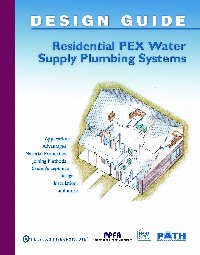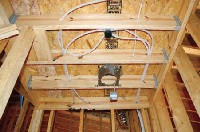Plumbing With Pex

In Alaska, “tubing season” lasts just three summer months when contractors are just as likely to spot fresh bear tracks at a construction site as they are discarded building materials.
“We may lay down 20,000 or 30,000 feet of radiant snowmelt tubing in those short months and another 150,000 feet of interior tube,” says Larry Partusch, president of Partusch Plumbing, Anchorage. “Many jobsites may have tubing in long before we can get to the boiler installations, but our customers know the realities of dealing with severe conditions and long, hard winters.”
His crews need to move fast through June, July and August, particularly considering a lot of company business is in new residential construction - and mostly large, custom homes for 25-30 key homebuilders.
“Since that’s the time frame we have to get it done in,” Partusch says, “we find a way through it.”
To get through plumbing these homes, Partusch was the first plumbing contractor to use a PEX plumbing manifold system in 1990. Seventeen years ago, contractors were just beginning to learn about PEX, and then, primarily as a means to carry warm water for radiant and snowmelt use.
For Partusch, using a PEX plumbing system was a time-saver, and anything that saves time also addresses the industry’s labor shortage. Partusch has just as much trouble finding skilled plumbers as the rest of the “48ers.” The Viega manifold system they use goes in relatively easily compared to metallic pipe. And the flexible nature of PEX means one roll can uncoil to 1,000 continuous feet. Compared to a traditional trunk-and-branch copper system, PEX can wiggle around framing and mechanical obstructions, reducing the need for cutting and fittings.
With less time spent on one job, Partusch says his younger plumbers gain more experience learning other skills, such as drainage and gas piping, which do require a bit more know-how.

Plumbing Use
PEX for plumbing is a speedy alternative to rigid pipe. Copper remains the most widely used material for water supply lines in the United States, installed in 41 percent of new homes, according to an annual building practices survey from 2005 by the National Association of Home Builders’ Research Center.But the survey also put the use of PEX for plumbing at 19 percent for new homes, not bad for a product that has only seen widespread use for plumbing in the last 10 years.
A majority of our readers were installing PEX plumbing in a survey Plumbing & Mechanical completed in 2003 - although it was a slim majority at 53 percent. In total plumbing installations, readers said they used copper 51 percent of the time and PEX at 43 percent, followed by CPVC at 5 percent.
By 2009, 73 percent of our readers expected to be installing more PEX plumbing systems.
Partusch’s abbreviated construction schedule highlights the time savings most contractors say is their biggest reason to use PEX for plumbing vs. metallic pipe. Fifty-five percent of our readers, for example, said “quicker installation time” was the No. 1 advantage of PEX plumbing.
For the homeowner, the PEX manifold systems operate as a sort of command center for water use. “PEX hot and cold distribution lines supply each side of each fixture with its own dedicated water line,” says Mike Cooke, Partusch’s manager of plumbing operations. “This helps to reduce water temperature and pressure changes, even when several fixtures are used at the same time.”
The typical higher-end home Cooke will plumb can be 7,000-8,000 square feet with four-and-a-half bathrooms and wet bar that go for about $700,000-$900,000, not including the four- or five-acre lot.
“But they can go a lot bigger than that out here; we see all sizes and shapes,” assures Cooke.
He adds that they also do “starter homes” in the $250,000 range - what it costs in Anchorage for a 1,700-square-foot, three-bedroom, two-bath home with no frills.
“But most of our homes are in the 2,500- to 4,500-square-foot range, and they’re almost exclusively - say, 99 percent of them - plumbed with PEX,” continues Cooke. The only exception is when an owner insists on copper. “The plumbing and mechanical recipe we’ve settled on is Viega PEX with one or two Maniblocs, a Bradford White 50-gallon, 65,000 Btu water heater - or the larger eF - and Grundfos hot water recircs, and SuperBrute or VersaFlo multi-speed pumps.”

Design Guide
The Partnership for Advancing Technology in Housing released a 128-page design guide for residential PEX plumbing systems last November to further help the plumbing and construction industry understand the alternative. The guide, prepared by the NAHB Research Center, compares three common layouts and then provides sample designs for a ranch house, two-story colonial, townhouse and condo. In order to quantify the differences between PEX system designs, each system was tested under controlled settings in a laboratory. Actual residential plumbing fixtures, piping layouts with fittings, and even elevation changes were installed.The guide details some of the following features and advantages for each type of design:
-
Trunk and
branch
- Simple system design conversion from rigid piping to flexible PEX piping.
- Opportunities to reduce the number of fittings installed.
- T&B systems will deliver hot water quicker during sequential flows.
- T&B systems will generally supply one fixture at a higher pressure.
- Easier piping runs to each fixture using smaller-diameter piping.
- Opportunity to eliminate all fittings between the manifold and the outlet.
- Opportunity to have centrally located individual shut-offs housed at the manifold.
- Quicker delivery of hot and cold water to the outlets.
- A more stable pressure to each fixture when operating simultaneous fixtures.
- Relatively simple system design conversion from rigid piping to flexible PEX piping.
- Opportunities to reduce the number of fittings installed.
- Quicker hot water delivery during sequential flows.
- Opportunity to have centrally located individual shut-offs housed at the remote manifold.
Homerun
Remote
manifold

More PEX
As stated in the beginning of this article, Partusch Plumbing also uses a lot of PEX for radiant and snowmelt. Military housing also has been a real source of business over the last couple of years. These aren’t exactly barracks. In this case, the military contracts with private developers to build entire residential communities, which the military leases. The developments include a good portion of the mechanical systems Partusch’s professionals install and regularly service.To keep up the pace, the company has figured other ways to save time besides installing PEX plumbing. For example, Partusch and business colleague Terry Bolton constructed a 13,000-square-foot building, with 10,000 square feet of additional snowmelt outside, in 1995.
“When the building was being designed, at the top of the list was the need for room - lots of it - for inventory,” Bolton says. “We wanted to be able to stash lots of inventory to reduce the need for installers to be at the wholesaler. Before, we lost a lot of time that way.”
As a result of the space, the company figures it makes fewer trips to the wholesaler than any other nearby firm.
The company also purchases its water heaters, plumbing fixtures and fittings, and many other supplies “direct-to-door.”
“We buy only through wholesale distribution, but they don’t need to handle the material or write an inventory for every unit,” explains Rick Thompson, who handles all billing and bid solicitations. “Instead, we’re invoiced for an entire truckload. This reduces the cost for the manufacturer, the wholesaler and for us. This means that we can be more competitive with shops that are buying all materials and supplies over the counter.”
Within a growing market, and with all this efficiency, Partusch says the company pays it off at the most important level - where the employee stands. “If we don’t offer employees the best work environment, the best salary, benefits and training, and the commitment to their safety, then we lose,” he says.
Opportunity is what made Partusch head north. He visited the Anchorage area as a young plumber from Omaha, Neb., in 1980 at a time when construction in the Midwest was in a downturn. Taking a gamble on a better future, he moved to Alaska and opened shop as Partusch Plumbing in 1982.
Bolton moved from Iowa to join him in 1987, and quickly headed up company subsidiary Northern Sheetmetal. “Here, radiant is king,” Bolton says. “And what some may think an oddity for Alaska homebuilding, air conditioning has become important, too. Our warmer summers have changed this for Alaskans. Few homes are being built today without considering it as an important option.”
In 1995 Cooke responded to Bolton’s insistence to join him (they’re cousins); the three formed what would become the core management team.
The company offers vacation pay, paid training time, medical, dental and retirement benefits with the company putting in 15 percent of gross wages, placed into individual SEP accounts.
“People tend to stay here,” Bolton adds. “Some have wandered out, but then quickly return.”

Protecting With PEX
An upcoming vote toward the end of this month could give a huge boost to an essentially new market for plumbers – fire sprinkler systems for new residential construction.The International Code Council will take a vote sometime between May 21-26 on whether to change its International Residential Code to make fire sprinklers mandatory for one- and two-family dwellings, as well as townhouses. The IRC governs most of this country’s residential construction and is currently in use by jurisdictions in 45 states and the District of Columbia.
If accepted this month, the fire sprinkler requirement would become part of the 2009 edition of the IRC.
The residential fire sprinkler market has been the next big thing since the National Fire Protection Association adopted its 13D standard on so-called multipurpose systems in 1980. Up to this point, about 200 municipalities throughout the United States require fire sprinklers for new residential construction. With a million or so new housing starts added annually to the 100 million existing homes, not surprisingly, only about 2 percent of the country’s homes have fire sprinklers.
Residential sprinklers can be installed as a standalone system - piping dedicated to only supplying water to sprinklers. In some ways, this is much like a down-sized commercial system for the home.
However, a multipurpose system integrates the fire sprinkler system with a home’s cold-water piping. In other words, the cold water that flows through a faucet is the same water that feeds the sprinklers.
Proponents say one piping system to do the work of two has obvious installation cost-savings right off the bat. And from a marketing standpoint, plumbers stand a better chance of being the ones to install such a hybrid since all homes have to be plumbed regardless.
The residential sprinkler system, be it standalone or multipurpose, can be made of most any common plumbing piping material, including copper and CPVC. In fact, CPVC dominates much of the miniscule residential market today. Even steel pipe, the traditional choice for commercial fire protection, can be used in residential although it is very uncommon.
At this point, only two manufacturers, Rehau and Uponor, are marketing the flexibility of PEX into a multipurpose system.
Regardless of the ICC vote, some state and local jurisdictions have restrictive licensing laws that may prevent the installation of a multipurpose system. As Julius Ballanco points out in a March article in sister publication PMEngineer, some areas require that the plumbing contractor also be a licensed sprinkler contractor.
Links
Looking for a reprint of this article?
From high-res PDFs to custom plaques, order your copy today!



